I am looking to see what’s involved in necking down a 416 ruger case to a 375ruger.
375 Ruger brass is hard to find at the moment.
i have some load developing I plan to do over the winter.
I can find 416ruger
I feel like running it trough a 375ruger die is probably too big of a jump in one pass?
Do I need a in between die?
I’ve never done this yet.
What do you guys recommend to neck down 416 to 375?
Too much hassle to be worth it ?
375 Ruger brass is hard to find at the moment.
i have some load developing I plan to do over the winter.
I can find 416ruger
I feel like running it trough a 375ruger die is probably too big of a jump in one pass?
Do I need a in between die?
I’ve never done this yet.
What do you guys recommend to neck down 416 to 375?
Too much hassle to be worth it ?








































































